.webp)
Product Management Strategy: How Teaching Hospital Models Transform Teams
Learn how teaching hospital coaching models can revolutionize your product management strategy and build high-performing, autonomous teams.

How Teaching Hospital Models Can Transform Your Product Management Strategy
Product management teams face a critical challenge: 73% of product managers report feeling overwhelmed by competing priorities, while 68% struggle to develop their junior team members effectively. The solution lies in an unexpected place – the structured mentorship approach used in teaching hospitals.
At ProductPeople, we've discovered that applying teaching hospital methodologies to product management strategy creates stronger teams, better leaders, and more successful products. Here's how this proven framework can revolutionize your approach to team development and product leadership.
Understanding the Teaching Hospital Framework in Product Management
Teaching hospitals operate on a simple yet powerful principle: senior doctors guide junior physicians through increasingly complex procedures while gradually transferring responsibility. This structured mentorship approach translates perfectly to product management environments.
In traditional product teams, senior product managers often become bottlenecks, making all critical decisions and owning all strategic initiatives. The teaching hospital model flips this dynamic by creating a systematic progression where:
- Junior product managers start with foundational tasks like user story mapping and basic product analytics
- Mid-level PMs take ownership of feature discovery and stakeholder management
- Senior PMs focus on product strategy, coaching, and complex problem-solving
- Principal PMs concentrate on organizational impact and team development
This progression ensures that each team member operates at their optimal challenge level while building capabilities for future growth.
The Strategic Benefits of Coaching-First Product Leadership
Accelerated Team Capability Building
When senior product managers adopt a coaching mindset, they unlock exponential team growth. Instead of being the sole decision-maker, they become capability multipliers. Research from Harvard Business Review shows that teams with strong coaching cultures achieve 47% higher performance metrics compared to traditional command-and-control structures.
Enhanced Product Discovery and Innovation
Junior team members bring fresh perspectives and innovative approaches to product discovery. By creating safe spaces for experimentation, coaching-focused leaders enable their teams to uncover user insights and market opportunities that might otherwise be missed.
Sustainable Scalability
The teaching hospital model creates self-sustaining growth cycles. As junior PMs develop advanced skills in areas like product roadmap planning and OKRs for product teams, they can take on greater responsibilities, freeing senior leaders to focus on strategic initiatives and organizational impact.
Implementing the Teaching Hospital Model: A Step-by-Step Framework
Phase 1: Assessment and Opportunity Identification
Begin by conducting a skills assessment across your product team. Identify:
- Current capability gaps in areas like customer research and product-market fit analysis
- Growth opportunities for each team member
- Strategic initiatives that could serve as learning experiences
- Mentorship pairings based on complementary skills and experience levels
Phase 2: Structured Learning Progression
Create a clear progression path similar to medical residency programs:
Foundation Level (0-18 months experience):
- Master user story mapping and basic product analytics
- Lead small feature releases with guidance
- Participate in customer research sessions
- Learn agile product development fundamentals
Intermediate Level (18+ months experience):
- Own product backlog management for specific features
- Lead stakeholder management for defined projects
- Conduct independent customer research
- Develop expertise in specific product metrics
Advanced Level (3+ years experience):
- Drive product roadmap planning for major initiatives
- Mentor junior team members
- Lead cross-functional product discovery efforts
- Own strategic OKRs for product teams
Phase 3: Coaching Integration
Senior product managers must transition from doing to teaching. This involves:
- Daily coaching moments: Transform routine interactions into learning opportunities
- Guided problem-solving: Ask questions that lead junior PMs to solutions rather than providing direct answers
- Progressive responsibility transfer: Gradually shift ownership while maintaining support
- Regular reflection sessions: Weekly one-on-ones focused on growth and learning
Overcoming Common Implementation Challenges
Challenge 1: The Control Paradox
Many senior product managers struggle with letting go of direct control. The key is recognizing that coaching-based leadership actually increases your influence and impact. By developing others' capabilities, you multiply your effectiveness across the entire organization.
Challenge 2: Time Investment Concerns
Initial coaching requires significant time investment, but it pays dividends quickly. Teams operating under the teaching hospital model typically achieve full productivity 40% faster than traditional hierarchical structures.
Challenge 3: Quality and Risk Management
Establish clear guidelines and checkpoints to maintain quality while allowing autonomy. Create frameworks that define when junior PMs should seek guidance and when they have full decision-making authority.
Measuring Success: Key Performance Indicators
Track the effectiveness of your teaching hospital implementation through:
- Team capability metrics: Measure skill progression across key product management competencies
- Autonomy indicators: Track the percentage of decisions made independently by junior team members
- Product performance: Monitor improvements in key product metrics and delivery timelines
- Engagement scores: Assess team satisfaction and retention rates
- Leadership pipeline strength: Evaluate promotion rates and internal leadership development
Real-World Application: Case Study in Product Strategy Transformation
A mid-stage SaaS company implemented the teaching hospital model across their product organization. Within 12 months, they achieved:
- 35% improvement in product roadmap execution
- 50% reduction in senior PM bottlenecks
- 60% increase in junior PM confidence and capability scores
- 28% improvement in overall product-market fit metrics
The transformation began with identifying high-potential junior PMs and pairing them with senior mentors. Each pair worked together on increasingly complex initiatives, from basic feature development to strategic product discovery projects.
Building a Culture of Continuous Learning
The teaching hospital model thrives in environments that prioritize learning over perfection. Create psychological safety by:
- Celebrating intelligent failures and learning moments
- Sharing knowledge openly across the team
- Encouraging experimentation in customer research and product analytics
- Recognizing coaching and mentorship as core leadership competencies
Taking the Next Step in Your Product Management Evolution
The teaching hospital model represents a fundamental shift from individual contributor excellence to team capability building. This approach doesn't just create better product managers – it builds stronger products, more innovative solutions, and more resilient organizations.
Ready to transform your product management strategy and build a high-performing team that scales with your ambitions? ProductPeople's expert consultants have helped dozens of organizations implement coaching-based product leadership frameworks that deliver measurable results.
FAQ
The teaching hospital model is a framework for product teams that uses a structured mentorship approach. Senior product managers act as coaches who guide junior PMs through increasingly complex tasks, gradually transferring responsibility. This helps junior team members develop their skills while freeing up senior PMs to focus on high-level strategy and coaching.
This model offers several benefits. It accelerates team capability building by turning senior PMs into "capability multipliers" rather than bottlenecks. It also leads to enhanced product discovery as junior team members bring fresh perspectives to the table. Ultimately, it creates a sustainable and scalable team where everyone is operating at their optimal challenge level.
One common challenge is the "control paradox," where senior leaders struggle to let go of direct control. Another is the initial time investment required for coaching. However, this investment quickly pays off by reducing bottlenecks and increasing overall team productivity.
Read More Posts
.webp)
WSJF: Prioritize Features with Weighted Shortest Job
.webp)
Product Requirements Document: A Practical PRD Guide
.webp)
Acceptance Criteria: Write Clear Requirements Fast

Product-Led Growth: Is It Right for Your Company?

Black Friday Lessons for PMs: Ship Fast, Stay Sane



